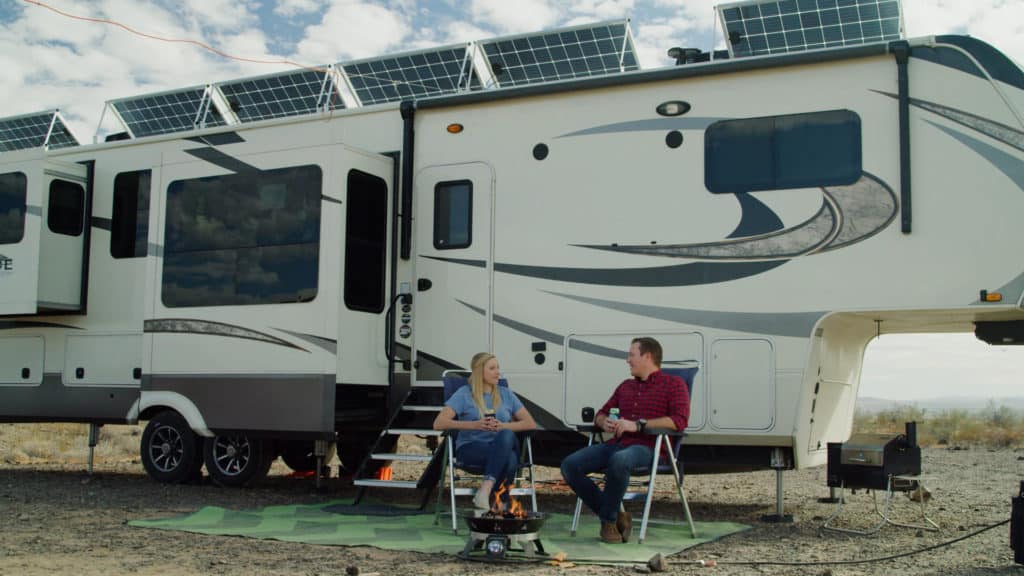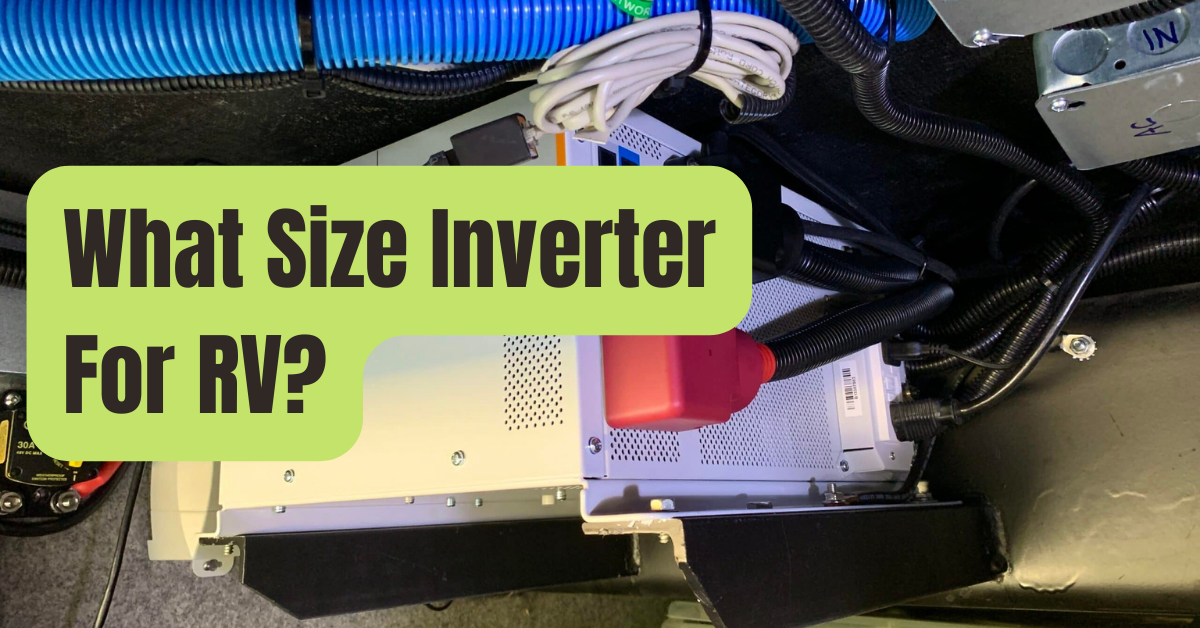Are batteries being installed in your RV for off-grid power? Congratulations if so! Off-grid electricity is a great option to expand your mobility and provide you the comfort to live off the grid.
The right inverter is a crucial component of your system.
You must thus be aware of the size of inverter required for your RV.
In the sections below, we go over what an inverter is, how to calculate your power requirements, and how to choose the best one for you.
Let’s start.
An RV Inverter: What Is It?
In order to define an RV inverter, we must first go through the various power sources in an RV.
Most electrical equipment operates on AC power, which is found in your house and has a voltage of 120 or 230 volts.
This is the kind of energy your RV gets when you hook it into shore power since it comes from the main electrical grid.
Because of this, when you connect to the grid, an inverter is not required.
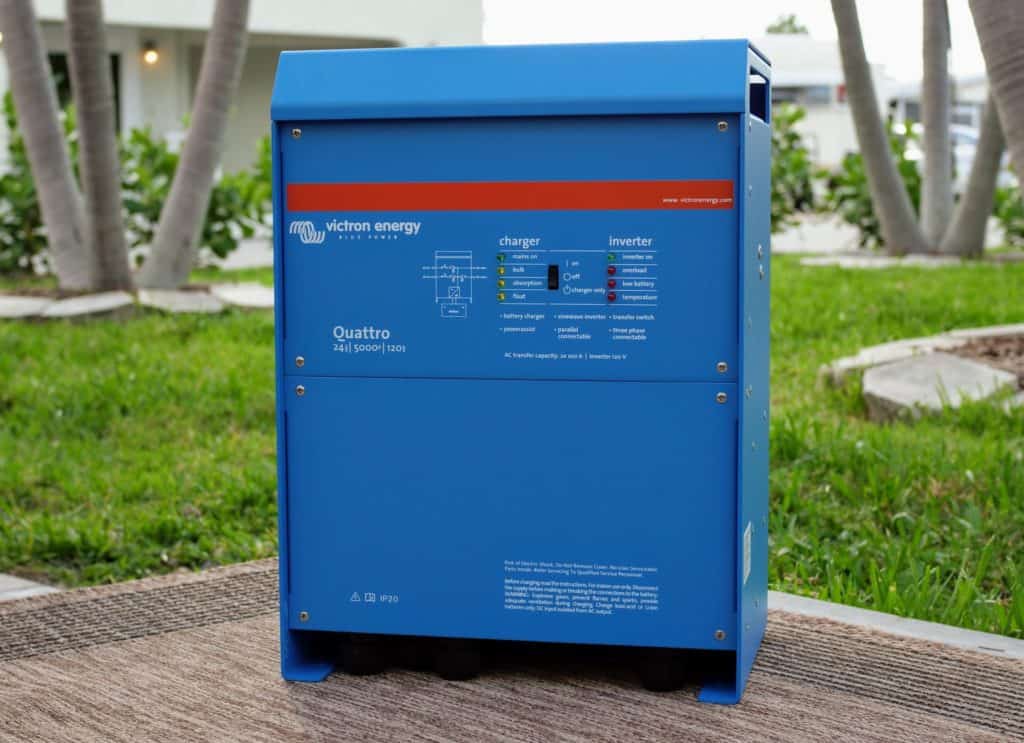
However, your batteries are powered by 12V DC.
The majority of the RV’s functioning lights and appliances are powered by this.
You must convert the DC power to AC electricity in order to power gadgets like your microwave, coffee machine, laptop, etc.
since it cannot operate higher power appliances.
Why do you do this? using an RV inverter!
How to Select the Correct Inverter Size for Your RV
There are many different sizes and abilities of inverters.
The ideal inverter size for your RV will depend on a number of variables.
Let’s look at the queries you need to ponder before buying.
What Attempts at Power Do You Make?
You must first decide which electronics and appliances you wish to power simultaneously.
This will enable you to choose the appropriate inverter size.
Make a note of all the equipment in your RV and figure up how many watts they each need to start.
As certain appliances (like microwaves and refrigerators) have strong surges when they initially launch, you’ll want to take both the operating watts and the surge needs into consideration.
Add 20% after calculating the total number of watts you’ll need to power (including surges).
This will inform you of the smallest inverter size required to power your gadgets.
When examining inverters, keep in mind that they usually have surge capabilities that they can withstand for only brief periods of time.

What Type and Capacity of Battery Bank Do You Have?
It’s crucial to match your inverter to the kind and capacity of your batteries.
An inverter that is too large for the battery bank can soon drain it and may not be properly powered by the batteries.
The following is a general rule-of-thumb advice for using our Battle Born Lithium batteries, while there is no specific need for size.
For every 1000 watts of inverter capability, we advise having a battery with a minimum capacity of 100Ah.
For instance, at least three 100Ah Battle Born Batteries would be required for a 3000-watt inverter.
The battery type is as crucial as the quantity.
When heavy loads are applied, lead-acid batteries lose a substantial amount of capacity due to their high Peukert exponent.
In order to mitigate this impact, using a bigger inverter with a lead-acid battery bank necessitates an enormous system.
For instance, lead-acid batteries need to be at least 800 Ah in capacity to run a 3000-watt inverter, but our lithium batteries can handle 300 Ah.
What Draws the Most Power for You?
Remember that not everything has to be powered by your inverter.
Understanding your biggest loads and how often you’ll be running them is a smart idea, however.
Before using a microwave, you may need to switch off other appliances if your inverter is barely 2000 watts.
Look at your heavy loads and oversize the inverter so that you have capacity if you don’t want to be concerned about this.
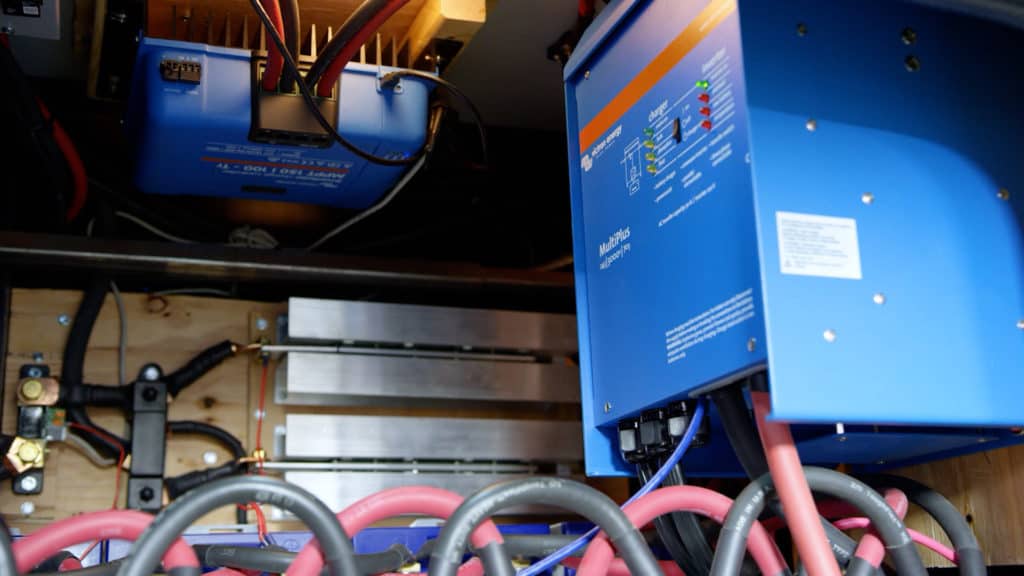
How to Determine the Power Needs of an RV
You’ll likely need an inverter size that falls somewhere in the center of the typical inverter range of 1,000 to 5,000 watts.
Many people who question what size inverter they need for your RV assume a far bigger size than is really required.
By adding up the most watts you’ll ever use at once and adding 20%, you can quickly determine the amount of inverter you’ll need.
Let’s imagine, for illustration purposes, that you need 1,500 watts to simultaneously power your computer and microwave.
Consider 1,500 Plus 300 (20% of 1,500), which is 1,800 watts.
This implies that you’ll need an inverter that is around average in size and at least 2,000 watts.
The most typical size used in RVs is a 2000- or 3000-watt unit.
Does The Whole RV Need To Be Powered By The Inverter?
Fortunately, no.
We would all need to acquire very strong inverters if this were the true.
You could want your whole RV on the inverter to power every outlet if you routinely go off-grid and boondock.
However, you may install an inverter to solely handle such demands if you need electricity for a short time or for a few outlets.
The option to connect your inverter to a subpanel in your RV is always available.
This implies that you could just have two or three outlets that can power gadgets, which is plenty for many of us.
You just need to make sure that your inverter can power the electronics that will be hooked into that subpanel in this situation.
Do Larger Inverters Have Any Negative Effects?
The more electricity an inverter uses merely to be on, the more power it uses even when it is not in use.
Large inverters will be less effective and consume more energy if they are only utilized for low loads since inverters work most effectively when they have higher loads on them.
As a result, it is not advised to oversize an inverter unless absolutely necessary for power requirements.
Can an Inverter Run an RV in Full?
Do you wish to power your whole RV with your impressive solar and battery setup? For the most part, inverters can achieve that.
In this situation, a hybrid inverter charger is advised.
They can convert DC power to AC electricity to charge your batteries in addition to inverting DC power to AC from your solar panels.
Hybrid inverters, like the Victron Multiplus series, may also combine electricity from your batteries with a shore or generator source.
As a result, you won’t overload the generator or breaker while using a smaller generator or shore power source.
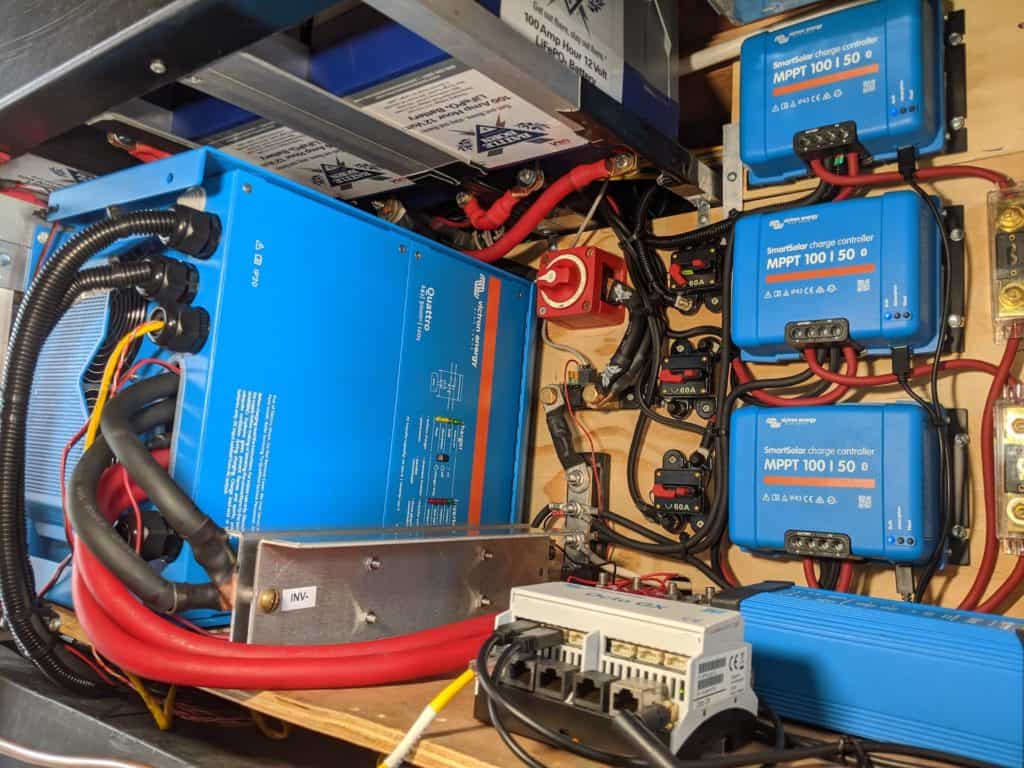
Can Many Inverters Be Used Simultaneously?
Yes! Despite the complexity of certain systems, inverters like the Victron multiplus may be connected in parallel to improve capacity.
Some inverters may even operate in parallel to provide output voltages up to 240V.
RVs may sometimes have numerous inverters installed to power certain appliances.
Running one huge inverter, for instance, would not be as effective as running a smaller one just for the fridge in an RV with a home refrigerator.
In this scenario, it may be possible to conserve energy by turning off the bigger main inverter and leaving the smaller one on to power the refrigerator.
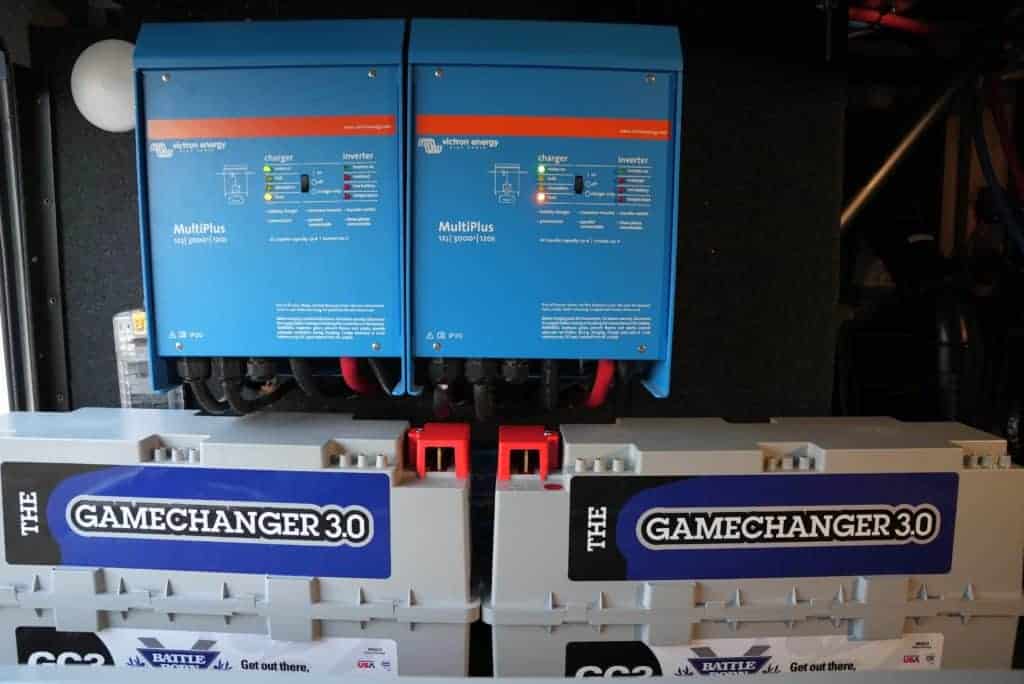
Does Your RV Need an Inverter?
Exactly how you travel in an RV depends on your style.
Do you intend to spend 99 percent of your time traveling at an RV park or campsite with full hookups? If so, an inverter won’t likely be necessary.
This is due to the fact that your RV will constantly be plugged into shore electricity (i.e., AC power).
Do you intend to go off the grid? Do you wish to camp out in wonderful, remote locations? If the answer is affirmative, an inverter is definitely required.
You will still want an inverter to convert the DC electricity from your batteries into useable AC power even if you don’t have solar power.
You could just want a modest 1,100 watt inverter, depending on the items you need to charge.
However, in order to at least be able to charge your phone, laptop, and any other devices you’ll be using while traveling, we advise having a mechanism to convert DC power to AC power.
Be Ready to Live Off the Grid
To convert solar and battery electricity into useable AC power if you want to live off the grid for a while, you will need an inverter.
This is because most appliances need AC electricity in order to function.
The last issue is: What size inverter do I need for my RV?
The amount of wattage your gadgets use, the size of your battery bank, and the way you travel all play a part in determining the answer to this question.
The reality is that each RVer will have a somewhat unique power setup.
Finding the ideal arrangement to increase your sensation of freedom while driving is truly what matters!
